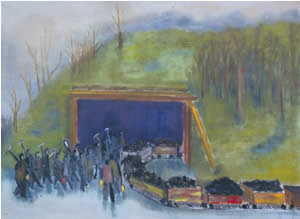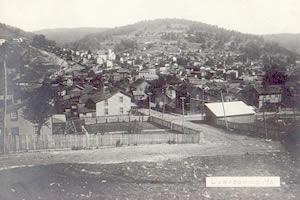The George’s Creek Regional Library History Room houses items that commemorate the past of Lonaconing and the George’s Creek area, donated or lent by community members. Chief among them, besides the Lefty Grove collection, are items dealing with the area’s rich mining history. The Library has photographs, postcards, lanterns, and a ledger containing the payroll for the George’s Creek mine for 1906-1907. Each item adds to the picture of life in this mining area nearly 100 years ago.

George's Creek Coal and Iron Company, a Baltimore and London syndicate, purchased 11,000 acres of land along the George's Creek in western Allegany County, Maryland. The Lonaconing iron furnace built in 1837 was the first in the United States to successfully use bituminous coal and coke, rather than charcoal, in making pig iron. The furnace produced pig iron from 1839 until 1855. By then the mining of coal had assumed a much more important industrial role and the George's Creek Coal and Iron Company, which already owned thousands of acres of land along with the mineral rights, turned to coal mining as its sole interest. Numerous other coal companies were formed and mines were opened on all hillsides. Workers flocked from Scotland, Wales, England, Ireland and Germany. Business was booming and all varieties of stores came into being to meet the needs of the people. Transportation improved and the railroad made several runs each day, bringing in people and materials and transporting goods to the market.
1907 saw the height of bituminous coal production in Maryland, with over 5 million tons being mined. In 1906 the average Maryland miner worked 250 days a year, for an average annual income of $489.97 (Harvey). Using the information from the payroll, it appears that the George’s Creek Coal and Iron Company produced 268,350 tons in the 12 months beginning December 1906. The company had a payroll in 1906-1907 of between 180 and 200 miners, each averaging 80+ tons in a month. Most of the miners were paid 60 cents per ton of coal they dug. Only a very few of the miners were still members of the United Mine Workers’ Union, after the strikes of 1894 and 1900, and George’s Creek had accepted the rate of 60 cents a ton in 1904 (Harvey).
On the June 1906 payroll, 6 of the 184 miners from George’s Creek received 72 cents per ton, not the 60 cents all others were paid. Samuel Brown was one of them and he was paid for 144 tons, considerably more than most miners. Why some miners earned more than others is not certain. But Harvey reported that Maryland mines allowed boys to work with their fathers or older brothers and their earnings were credited to the adult member of the team. The numbers of boys was reduced over time, but in 1907 there were still some boys under 16 working. This was known as the half turn system. A turn entitled a miner to a car for removing the coal he had dug. A son accompanying his father could get a half turn that gave the father the opportunity to dig and load extra coal, to get a turn and a half.
From the miners’ salary deductions of 1% per ton were subtracted to pay to the blacksmith who sharpened their picks and other tools. In addition, most miners had a $1 deduction to pay the company doctor, and some also bought fuel from the George’s Creek Coal and Iron Company.
There were almost 100 other workers on the payroll beside miners. Other categories included clerk, engineer, foreman, smith, roadman, carpenter, brakeman, wheelman, driver, dumper, and watchman, as well as inside laborers and outsider laborers. One man worked in the shop. The company also paid two surveyors, presumable to find new sources of coal as the veins were worked out. The weigher was responsible for weighing each loaded mine car and crediting the weight of the coal to the miner. Many of the miners were paid extra to clear snow after the heavy snow fall in February 1907.
The company also bought props and ties to timber the headings, that is, to prevent the roof of the mine from crashing down as the coal was taken out. They provided the timber to the miners free of cost, but in return the miner was compelled to keep his area timbered, to keep the working space stable, and he was not paid for the time it took to put the props in place. Timber was also used for the rails for the haulage of the mine cars, and the miner had to attend to the tracks to get his coal car to the main track. The Click family ran the stables in 1906 - 1907, and the company paid for hay and oats for the horses and mules, which pulled the carts to the surface, and possibly to the tipple.
In 1910 the George’s Creek Coal and Iron Company became the George’s Creek Coal Company. By 1918 their mines in the “Big Vein” were abandoned, and in 1930, the company produced less than 3% of the coal mined in Maryland, according to the Baltimore Association of Commerce, and had fewer than 100 employees. Mining continues in the George’s Creek basin today, with the majority being surface mines. The total 2003 coal production for Maryland was less than 2 million tons (US Department of Energy), with fewer than 150 men involved (Maryland Department of Labor), a far cry from the peak years of the early 1900s.
Three periods of the George’s Creek Coal and Iron Company’s payroll have been included on this website – June 1906, February 1907 and November 1907, in order to cover as wide a period as possible and to record seasonal differences in employment. The George’s Creek Library has the ledger and other bi-monthly periods between June 1906 and November 1907 can be seen there.
Thanks to the community members who shared their photographs and artifacts with the library; Sandy Grandstaff of the George’s Creek Promotion Council; Debbie Hartman of the George’s Creek Library; Elizabeth Levy Malis for permitting her grandmother’s painting to be included; Al Feldstein of Cumberland, MaryJo Price of Frostburg University Library and Betty Van Newkirk of the Frostburg Museum for sharing their knowledge.
Additional reading
Baltimore Association of Commerce. The coal-mining industry of Maryland. Maryland Development Bureau, 1932.
Levy, Ruth Bear. A wee bit o' Scotland : Growing up in Lonaconing, Maryland, at the turn of the century. Baltimore: Maryland Historical Society, 1983.
Harvey, Katherine A. The coal miners of Western Maryland: Some economic and social developments, 1859 – 1910. Master’s thesis, 1962, available at Frostburg University Library
Harvey, Katherine A. The best-dressed miners: life and labor in the Maryland coal region, 1835-1910. Cornell University Press, 1969.
Lonaconing: home in the hills. Cumberland, 1987.
Maryland Geological Survey. Second report on the coals of Maryland. The Johns Hopkins press, 1920.
